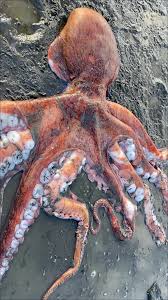The Giant Pacific Octopus: Nature’s Extraordinary Cephalopod

Introduction
The giant Pacific octopus (Enteroctopus dofleini) is a remarkable marine creature known for its incredible intelligence and adaptability. As one of the largest octopus species in the world, it plays a crucial role in its ecosystem and captivates marine biologists and enthusiasts alike. Understanding this fascinating creature is essential not only for marine conservation efforts but also for appreciating the complex biodiversity our oceans encompass.
Physical Characteristics
The giant Pacific octopus can weigh up to 110 pounds (50 kg) and reach a length of over 16 feet (5 meters) from head to tentacle end. Its body is characterized by a bulbous head, large eyes, and eight long arms lined with sensitive suckers that can detect taste and touch. These octopuses exhibit a unique ability to change their color and texture to blend into their surroundings, a skill that aids in both predation and evasion from predators.
Habitat and Distribution
This species is primarily found along the Pacific coast of North America, ranging from California to Alaska, and is often discovered in rocky coastal areas, tide pools, and deep-sea environments. The giant Pacific octopus favors environments where it can find plenty of hiding spots, as it is a solitary and nocturnal creature. During the day, it often stays hidden in dens made from rocks and coral.
Behavior and Diet
Giant Pacific octopuses are known for their remarkable problem-solving skills and high intelligence. They are capable of remarkable feats, such as opening jars to fetch food, which has drawn significant scientific interest. Their diet primarily consists of crabs, clams, fish, and other marine life. They use their beak-like mouths to puncture shells or prey, showcasing their adaptability and hunting prowess.
Reproduction and Lifespan
Reproduction occurs in the spring, where females lay up to 100,000 eggs in a den and meticulously care for them for several months. Unfortunately, after hatching, the female octopus often dies, emphasizing the species’ unique but tragic life cycle. Giant Pacific octopuses have an average lifespan of 3 to 5 years in the wild, though some can live longer in captivity where they are protected from predators.
Conclusion
The giant Pacific octopus is not only an intriguing species due to its size and intelligence but also serves as an important indicator of ocean health. As climate change and human activities continue to impact marine ecosystems, it is crucial that we strive to protect these remarkable creatures and their habitats. Understanding the giant Pacific octopus is vital for promoting conservation efforts and ensuring the continued survival of this extraordinary cephalopod.









